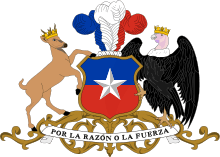Chilean mythology
Evolution
Chilean mythology covers of a large collection of myths and legends from the beliefs of Chile's indigenous groups (Mapuche, Tehuelche, Aymaras, Changos, Diaguitas, Picunches, Pehuenches, Huilliches, Poyas and more).
Their mythology shows a significant influence by European colonization, mainly during the Spanish colonial period. These influences have helped Chilean mythology to evolve and become distinct from other local mythologies such as Chilota mythology. The varied terrain and climate throughout Chile further influenced the development of beliefs and myths that expanded the country's collective culture.
Mythological division
In the study classification of ″Chilean mythology″, the myths are typically categorized geographically into Northern, Central, Easter Island and Southern Zones.
Northern Zone
These myths and legends involve characters closely related to the desert, religious devotion and mining. Examples include the myth of Alicanto, la Lola, el Yastay, the Achaches, the Umpillay, and the Quilpaná. Other legends are Juan Soldado, the treasure of Guayacán, the Payachatas, La Tirana and the virgin of Andacollo. The northern myths draw upon the Inca and pre-Incan civilizations, but they became distinguished through a rooted base in Spanish colonialism.
Central Zone
These myths assimilated of many mythological characters from Mapuche tribal beliefs.
The Spanish initially settled in the central zone, the most populated, leading to a unique mixture.
This zone hosts many legends modified from the oral tradition. Some of the mythical figures include Pedro Urdemales, la Calchona, la Llorona, el Culebrón, el Chonchón and the Piuchén. Legends include the Inca Lagoon, the Burial of Cacique Vitacura and Rere's Bell. Additionally, stories discuss the appearance of the devil and encounters with witches.
Another is the legend of the treasure of Juan Fernández, in the Juan Fernández archipelago.
Easter Island
The most important myth source is Easter Island. The inhabitants of Easter Island, the Polynesian Rapa Nui people, created singular explanations about the creation of man and their land. Examples of these myths include: Make-Make and Aku-Aku.
Southern Zone
This zone was also influenced by Mapuche indigenous beliefs. Legends include the City of the Caesars, The Three Pascuales, and spirits of Mapuche beliefs like Pillán, the Wangulén, the Wekufes, the Anchimallén, Tented and Caicos, and the Cuero.
Chiloé
The Chiloé Archipelago has its own stories, due to the geographical isolation and the union of indigenous and Spanish traditions. Natural phenomena such as mist, strong winds, thick forests, and rough seas feature in legends there. The most important are the Caleuche and the Trauco, followed by the Fiura, the Pincoya, the Invunche, the Camahueto, the Basilisco chilote, and the Millalobo.
Mythologies and Legends
The most important sources are:
- Indigenous:
- Mapuche mythology
- Rapa Nui mythology
- Others:
- Chilota mythology
- City of the Caesars
- Alicanto
Iconography
Marcela Donoso, a Chilean painter, made a set of oil paintings describing 30 Chilean myths. A book includes these paintings.
See also
References
- Myth and Magic Infuse Chilean Island 2008 (English)
- Antonio Acevedo Hernández. Leyendas de Chile. Colección Leyenda y tradición. Biblioteca Quimantú para todos. Quimantú, 1971. (Spanish)
- Keller, Rueff (1972). de Vivar, Jerónimo (ed.). Mitos y leyendas de Chile. Enciclopedia moderna de Chile. de Vivar.
- Saavedra, Yolando Pino (1967). Folktales of Chile. Routledge & K. Paul.
